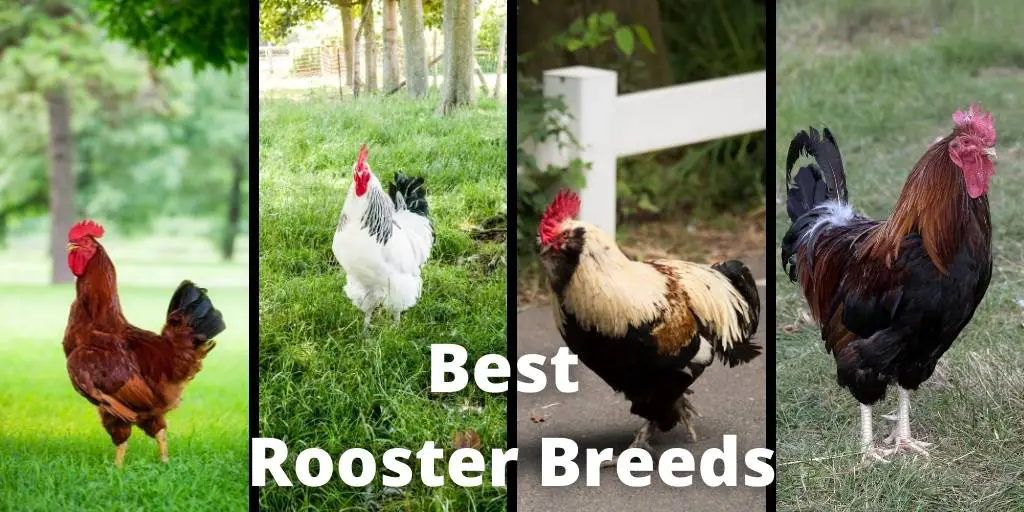Selecting a rooster isn’t just about choosing the flashiest bird – it’s about finding a breed that fits your goals. Modern roosters are often cross‑bred to combine traits such as good egg production, hardy constitutions, and calm demeanours.
When you’re choosing a bird, look at its size, temperament, climate tolerance, feed requirements, and how it fits with the rest of your flock. A friendly rooster can provide protection, fertilise eggs, and even act as a charming flock mascot.
Below you’ll find 21 of the most popular rooster breeds along with their main benefits and the few drawbacks you should know about.
Use the pros and cons lists to decide which birds fit your backyard needs, and check the links to our coop and feeding guides for more information on care and housing.
1. Brahma Chicken
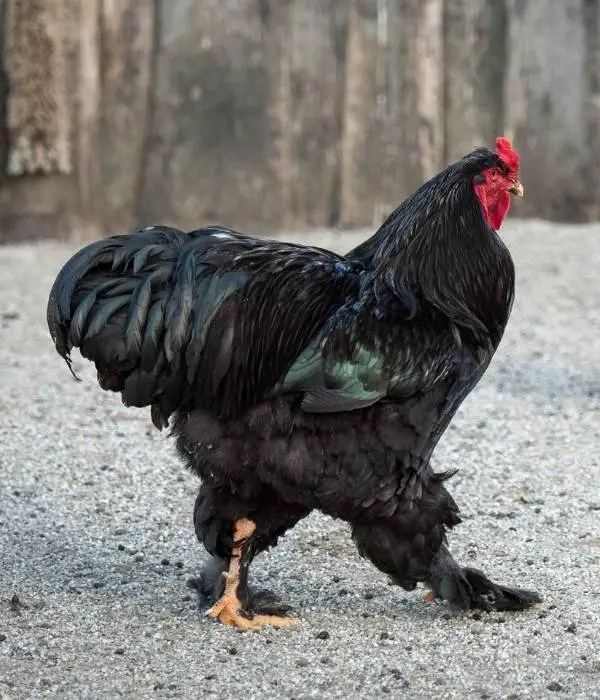
You’ll sometimes hear people call the Brahma the “King of Poultry” because of its imposing size and gentle nature. These heavy birds have broad heads, smooth plumage down to the shanks and toes, and come in dark, light, and buff colour varieties.
Roosters can stand around 30 inches tall and weigh about 12 pounds, while hens are around 9–10 pounds.
Imported from the Chinese port of Shanghai in the 1840s, the ancestors of today’s Brahmas were big feather‑shanked birds that Americans crossed with Chittagong fowls to create a new breed with a beetle brow and pea comb.
By the mid‑1800s, Brahmas were prized meat birds in both the United States and England and were later standardised into three colours – light, dark, and buff. Because of their size and calm disposition, Brahmas were once the leading meat chicken and remain popular as winter egg layers and backyard pets.
Benefits of Brahmas
- Dual‑purpose birds: Brahmas lay about 3–4 brown eggs a week and are large enough to produce a good carcass.
- Hardy in cold weather: Their dense plumage helps them thrive in cold climates, and they lay well from autumn through spring.
- Calm and docile: They are friendly, quiet roosters that rarely show aggression.
- Easy to confine: Because of their weight, Brahmas don’t fly well and are simple to fence in.
Small problems
- High feed bill: Their large size means they consume more feed than lighter breeds.
- Mud and frostbite: Feathered feet collect mud; if they get wet in winter, the toes can suffer frostbite.
- Slow to mature: It can take several months before Brahma pullets begin laying and roosters reach their full weight.
2. Delaware Chicken
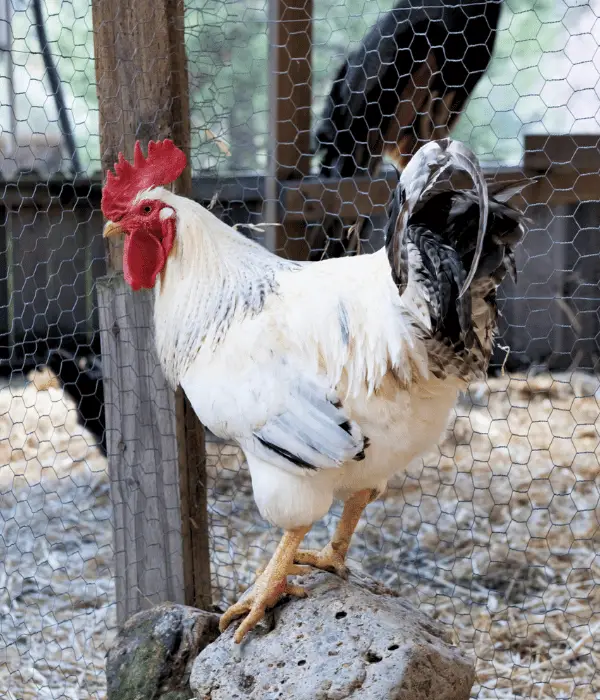
Originally bred in the 1940s from New Hampshires and Barred Rocks, the Delaware is a dual‑purpose bird with white plumage and black speckles on the hackles and tail. Roosters weigh about 7½–8½ pounds and hens 5½–6½ pounds.
The Delaware was developed to supply the fast‑growing broiler market on the U.S. East Coast, but was quickly replaced by the Cornish Cross when hybrid broilers took over.
Despite its brief commercial heyday, the breed has found new life on small farms where its heritage genetics, attractive plumage, and balanced size make it a valuable dual‑purpose addition.
Benefits of Delawares
- Productive egg layers: Expect around 250–280 large, light‑brown eggs per year.
- Quick maturing: They mature faster than many heritage breeds and start laying at roughly 16 weeks.
- Hardy and low‑maintenance: Delawares tolerate both heat and cold; they thrive on free range but also adapt to confinement.
- Friendly temperament: They are talkative but generally gentle; roosters make good flock protectors without being overly aggressive.
Small problems
- Not dependable brooders: Hens rarely go broody, so you’ll need an incubator or broody hen for chicks.
- Feather quality varies: Strains bred for meat may have poorer feather coverage and are more prone to heat stress.
3. Australorp Chicken
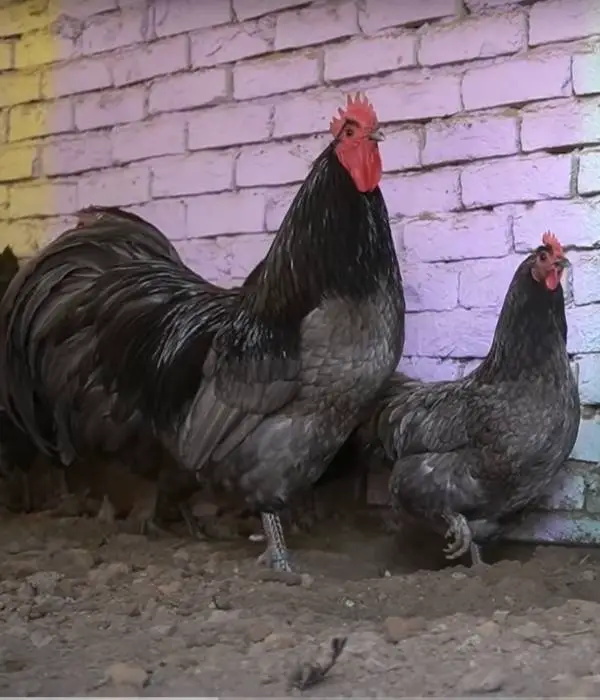
Australorps are glossy black chickens from Australia whose feathers shine green in sunlight. Roosters reach 8½ pounds and hens around 6½ pounds. They’re celebrated for setting a laying record of 364 eggs in one year.
This breed was selectively developed from Black Orpingtons in Australia to excel at egg production. Australorps achieved worldwide fame in the 1920s when teams of hens broke multiple egg‑laying records; one hen famously laid 364 eggs in 365 days.
The only recognised plumage colour in the United States is black, but blue and white varieties exist elsewhere. Their combination of glossy plumage, single combs, and record‑breaking productivity has made them a favourite in backyard flocks.
Benefits of Australorps
- Excellent layers: They produce around 250 medium‑sized brown eggs per year.
- Gentle and calm: Australorps are docile and easy to handle; they rarely bully smaller flock‑mates.
- Smart foragers: These birds actively patrol your yard for bugs and adapt well to free range.
- Good mothers: Hens are moderate brooders and care for chicks well.
Small problems
- Not ideal meat birds: Australorps are slim compared with true meat breeds.
- Don’t like tight confinement: They perform best when allowed to roam; confined birds need enrichment.
- Heat sensitive: Provide shade and cool water in very hot climates.
4. Croad Langshan
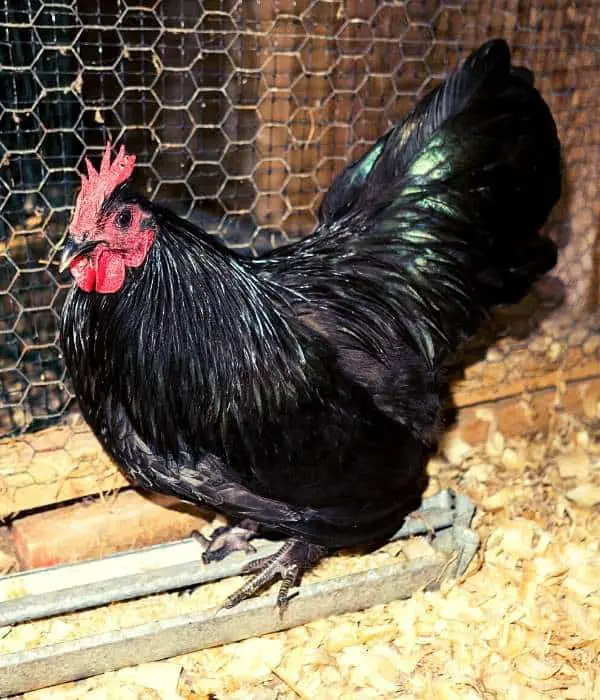
Originally from China, Langshans are tall, elegant birds with a U‑shaped profile and a long tail. Roosters weigh about 9½ pounds and hens 7½ pounds.
The Langshan takes its name from the Langshan district of China, where it was prized as a triple‑purpose bird for its meat, eggs, and beautiful carriage.
Introduced to the West in the late 19th century, the breed comes in black, white, and blue varieties and is noted for a high stance, deep breast, and a gracefully curving tail.
Langshans mature slowly but repay patience with rich‑flavoured white meat and large brown eggs during the winter months.
Benefits of Langshans
- Dual‑purpose: Hens lay 140–150 large dark‑brown eggs per year and are good winter layers.
- Docile and friendly: Langshans are easily tamed and seldom aggressive.
- Adaptable: They tolerate confinement or free range and are comfortable on most soils.
- Quality meat: Langshan meat is white and considered flavourful.
Small problems
- Slow growing: They mature more slowly than hybrid breeds.
- Prone to frostbite: Their long legs and feathers can get wet; frostbite is a risk in cold, damp conditions.
5. Cochin Chicken
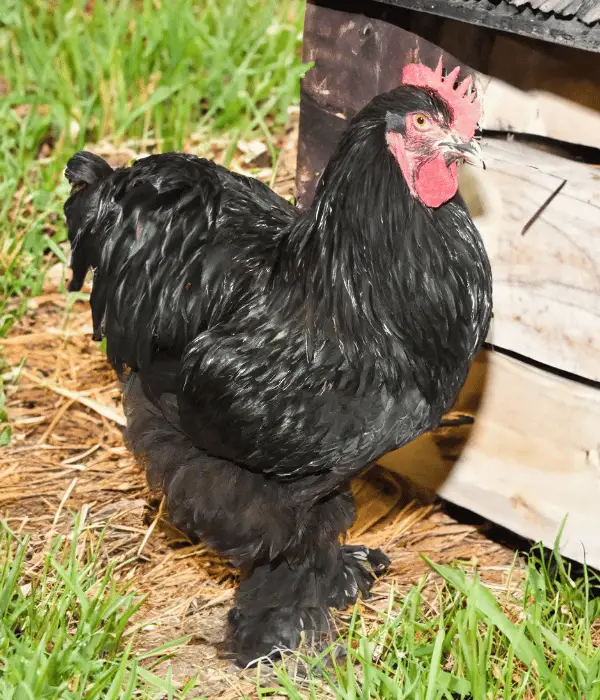
Cochins are heavily feathered birds from China with foot feathers and a round body. Roosters weigh about 11 pounds and hens 8½ pounds.
Descended from the “Shanghai” or Cochin China fowls that fuelled the 1850s hen fever craze, Cochins were imported to the West for their novelty.
Today, you’ll find them in thirteen recognised colours, including buff, black, blue, and partridge, with even more options in bantam form.
Their profuse plumage covers not just their bodies but also their legs and toes, giving them a comically fluffy appearance. Because of their docile temperament and maternal instincts, they’re often used to hatch the eggs of other poultry.
Benefits of Cochins
- Superb brooders: Cochins are renowned for their maternal instincts and will hatch eggs from chickens, turkeys or ducks.
- Cold‑hardy: Their profuse plumage makes them ideal for cold climates.
- Gentle temperament: Roosters are docile and rarely quarrel.
- Good capons: When raised as capons, they produce excellent meat.
Small problems
- Poor flyers: Their weight means they need low perches and plenty of room on roosts.
- Feet need care: Feathered toes collect mud; frostbite and foot infections are possible.
- Moderate egg production: Hens lay 150–200 brown eggs annually and start later than faster breeds.
6. Barred Plymouth Rock Chicken
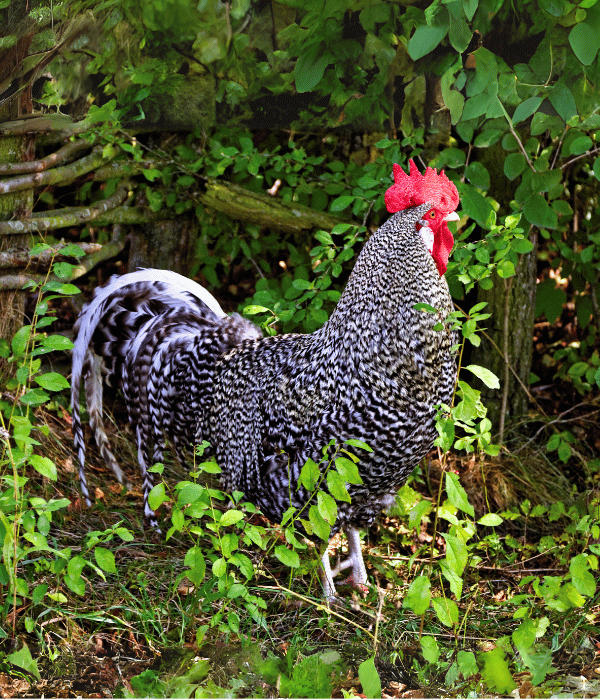
Barred Rocks are classic dual‑purpose birds with alternating black and white barring. Roosters reach 9½ pounds and hens about 7½ pounds.
Developed in New England during the 19th century, the Plymouth Rock became one of the most ubiquitous American breeds. During World War II, it was a mainstay of backyard “victory gardens” because it produced a steady supply of meat and eggs.
The characteristic crisp black‑and‑white barring is most visible in roosters and helps camouflage them from aerial predators. Rocks are generally hardy and long‑lived and will continue laying into their third year.
Benefits of Barred Rocks
- Steady layers: Hens produce about 230 large brown eggs annually in their first three years.
- Hardy and adaptable: They tolerate both hot and cold climates and suit free range or confinement.
- Docile but alert: Barred Rocks are friendly with people yet have enough awareness to avoid predators.
- Low maintenance: They require little special care and are good for beginners.
Small problems
- Susceptible to parasites: Keep them on fresh ground and practice regular worming.
- Flock hierarchies: Roosters may become assertive; ensure adequate space to reduce squabbling.
7. Barbu d’Uccle Chicken
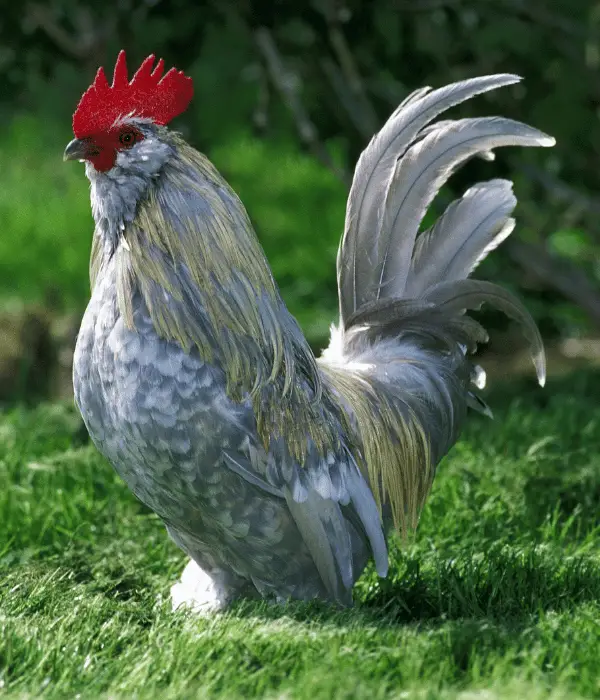
The Belgian bearded d’Uccle is a true bantam with a beard, muff, and feathered legs. Roosters weigh about 1.5–2 pounds (650–750 g) and hens 1.3–1.6 pounds.
This diminutive bird was created in the early 1900s by Belgian breeder Michael Van Gelder by crossing the Antwerp Belgian and the Booted Bantam.
The resulting breed retained the low posture, beards, and single combs of its ancestors while adding flashy, feathered feet.
Its most sought‑after colour is millefleur (“thousand flowers”), but d’Uccles comes in more than two dozen colour patterns. Their small size and quiet nature make them ideal for urban flocks.
Benefits of d’Uccles
- Charming pets: Their small size and friendly nature make them ideal for families; they enjoy human interaction.
- Broody hens: Hens readily go broody and make attentive mothers; they lay about three small white eggs per week.
- Beautiful plumage: Available in many colours, including the popular millefleur pattern.
- Cold‑hardy: Dense plumage helps them tolerate cool climates.
Small problems
- Wet feet issues: Feathered legs dislike muddy, wet ground.
- Not free‑range hawks: Because they are small and can fly, they need a covered run to prevent escapes and protect from predators.
- Limited egg production: They only lay about 100–150 eggs per year, so not ideal if you want lots of eggs.
8. Welsummer Chicken
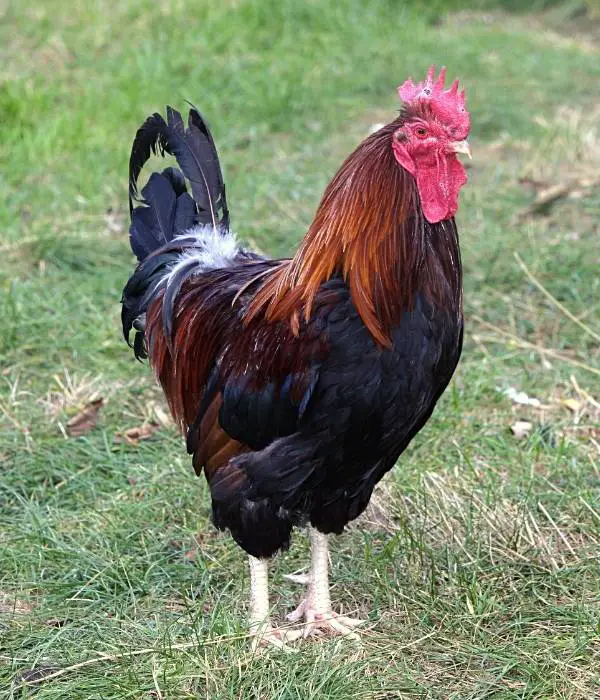
Welsummers hail from the Dutch village of Welsum and are famous for their rich brown, speckled eggs. Roosters weigh about 7 pounds and hens around 6 pounds.
The breed was developed after World War I by crossing local Dutch chickens with breeds such as Barnevelders and Rhode Island Reds to improve egg colour.
Welsummer roosters sport partridge‑red hackles and saddle feathers and have handsome black tails. The birds’ friendly disposition and self‑sufficiency make them popular on homesteads, and their eggs are among the darkest brown of any standard breed.
Benefits of Welsummers
- Beautiful eggs: Hens lay terracotta‑coloured eggs with speckles; expect 150–180 eggs in the first year.
- Good foragers: They are active birds that enjoy roaming and finding their own food.
- Calm roosters: Most roosters are aloof but not aggressive and can protect the flock.
- Easy autosexing: Day‑old chicks can be sexed by head markings, making breeding straightforward.
Small problems
- Aloof personality: They don’t like being cuddled and can be stand‑offish.
- Limited cold tolerance: They do better in cool, wet climates than in extremes; provide warm roosting spots in winter.
- Prone to predators: Their colour makes them vulnerable to aerial predators, so overhead protection is important.
9. Buff Orpington Chicken
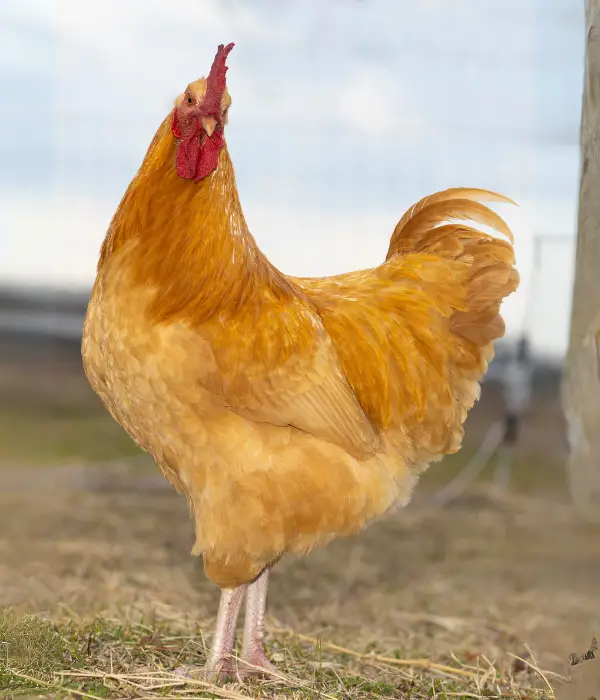
Buff Orpingtons are large, fluffy birds developed in England in the late 1800s. Standard roosters weigh around 4.5 kg (about 10 pounds) and hens about 3 kg (6½ pounds). Their soft golden plumage makes them one of the prettiest backyard breeds.
William Cook created the Buff Orpington by crossing several breeds, including Minorcas and Langshans, to produce a utility chicken that would lay well and provide meat. The result was a golden‐buff bird with a single comb, short back and full breast. Because of their quiet nature and tendency to enjoy human company, Buff Orpingtons have become favourite “lap chickens” in suburban settings.
Benefits of Buff Orpingtons
- Excellent layers: Hens lay 200–250 large light‑brown eggs annually.
- Docile “lap chickens”: They are quiet, friendly and enjoy human attention.
- Cold‑hardy: Thick feathers provide good insulation for winter.
- Good brooders: Many Buff Orpington hens go broody and make attentive mothers.
Small problems
- Heat sensitive: Provide shade and plenty of water in hot climates to avoid heat stress.
- Prone to bullying: Their docile nature means they may be bullied by more assertive breeds.
- Obesity risk: They love food and can become overweight; monitor feed and treats.
10. Sebright Chicken
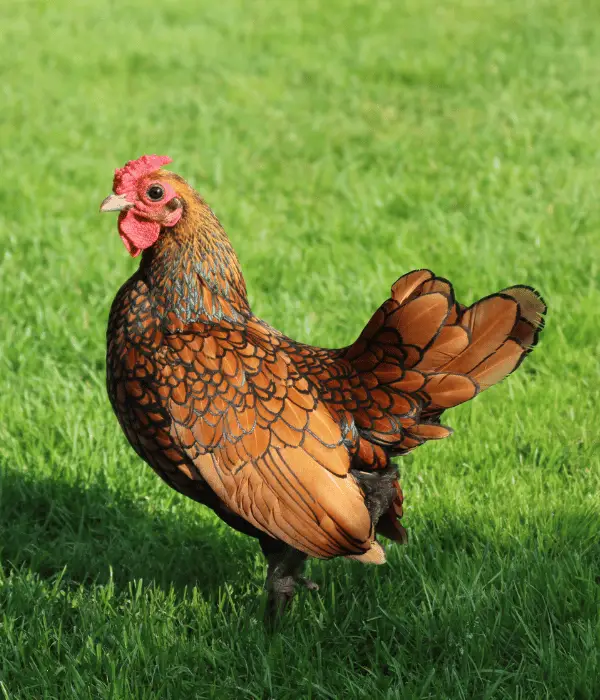
Sebrights are small, true bantams that were developed in Britain. They are characterized by their laced plumage and standing erect. Males weigh approximately 22 oz (1.4 lb) and females about 20 oz.
This breed was developed by Sir John Saunders Sebright in the early 19th century. The breed originated from the crossing of game bantams and a combination of Polish and Hamburg breeds of chickens.
Sir John was able to create one of the first breeds that had roosters with hen-feathering of no long saddle and hackle feathers generally seen in a male.
Sebrights consist of two varieties recognized by the British Poultry Association: gold and silver, with both varieties having intricate black lacing outlining each feather.
Benefits of Sebrights
- Ornamental beauty: Their gold or silver feathers with black lacing make them eye‑catching show birds.
- Spunky personalities: They are active and curious and can be easily tamed when handled young.
- True bantams: Without a larger counterpart, they fit easily into small backyards.
Small problems
- Poor layers: Hens only produce 60–80 small eggs per year and rarely go broody.
- Cold sensitive: They don’t handle damp, cold weather well; provide warm, dry housing.
- Flighty: They can fly into trees and may need a covered run.
11. Polish Chicken
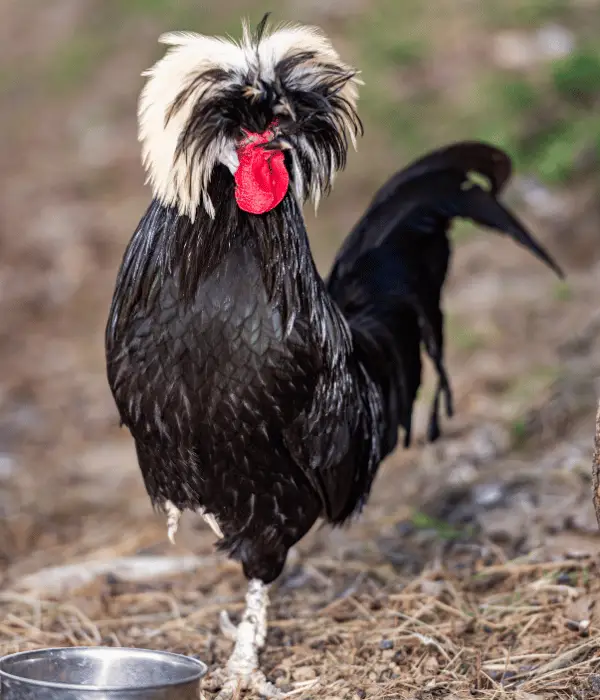
Polish chickens are known for their extravagant feather crests that often obscure their eyes. Standard roosters weigh about 2.75 kg (6 lb) and hens 2 kg (4½ lb).
The exact origin of the Polish is unclear, but crested fowl resembling them appear in 16th‑century Dutch paintings. The breed likely reached England and France from Eastern Europe and became popular as an ornamental bird.
Polish roosters have a distinctive V‑shaped comb hidden beneath their crest, and varieties range from white‑crested black to golden‑laced. They are prized for their looks rather than their productivity.
Benefits of Polish Roosters
- Unique appearance: Their large crests and many colour varieties make them striking ornamental birds.
- Good egg layers: Historically, they were productive layers; modern strains lay a moderate number of small white eggs.
- Gentle disposition: They are generally calm and can coexist in mixed flocks.
Small problems
- Limited vision: Large crests can hinder sight, making them nervous and prone to predators.
- Not cold hardy: Provide protection from wet weather to prevent crests from becoming waterlogged and freezing.
- Occasional flightiness: They may startle easily when approached from behind due to limited vision.
12. Java Chicken
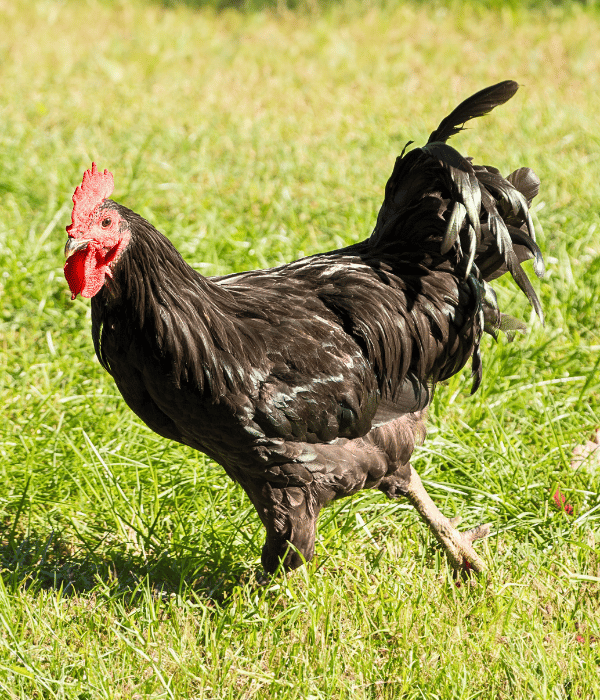
Java is one of the oldest American breeds, developed before 1850. Roosters weigh about 9½ pounds, hens 7½ pounds and they lay 150–180 large brown eggs per year.
Javas were foundational to the development of several later breeds, including the Plymouth Rock and the Rhode Island Red. They come in black, mottled, and white varieties and have a long, broad back with a deep breast.
The birds are calm and self‑reliant, preferring to forage but tolerating confinement if given enough space.
Benefits of Javas
- Reliable layers: Hens continue laying well into winter and have a long laying life.
- Good foragers: They prefer ranging and excel at finding their own food.
- Calm temperament: Javas are friendly and seldom aggressive; they make good birds for children.
- Hardy: They handle both hot and cold climates and are good mothers, going broody easily.
Small problems
- Slow growth: Javas mature slowly; roosters reach market weight later than hybrids.
- Need space: They like to range; confining them without enrichment may lead to boredom.
13. Aseel (Asil) Chicken
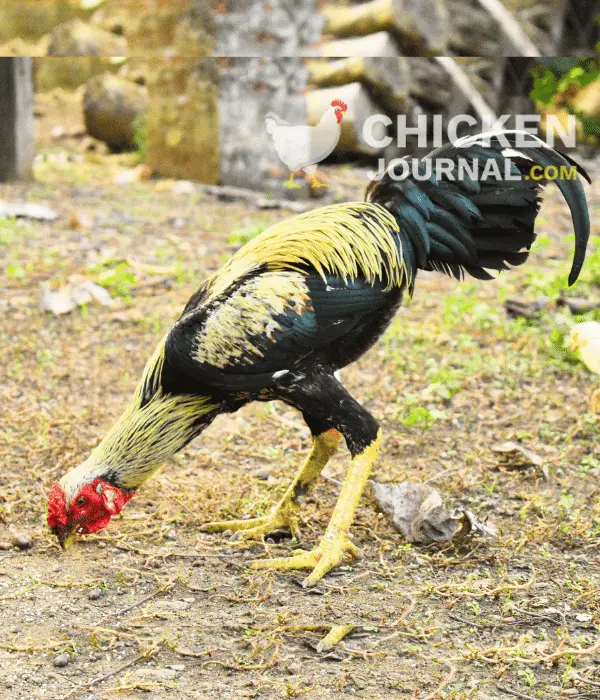
Aseel chickens originate from South Asia and were bred for cockfighting. Roosters weigh 1.8–2.7 kg (about 4–6 pounds) and hens 1.35–2.25 kg.
The word “Aseel” means “purebred” in Arabic, and this ancient breed was prized in India and Pakistan for its courage and tenacity. It has a muscular body, upright posture, pea comb, and short, tight feathers.
Many colour varieties exist, from wheaten to black‑red. Because Aseels mature slowly and hens lay few eggs, they are kept primarily for exhibition or heritage preservation.
Benefits of Aseels
- Hard‑muscled birds: Their compact build makes them impressive and strong.
- Good sitters: Hens lay few eggs (up to about 40 per year) but are reliable brooders.
- Adaptable: They handle hot climates well and are hardy in both hot and humid conditions.
Small problems
- Aggressive tendencies: Roosters and even hens can be pugnacious; careful management and separation are required.
- Poor layers: Only 5–20 eggs per year.
- Not for beginners: Because of their temperament, they’re better for experienced keepers.
14. Silkie Chicken
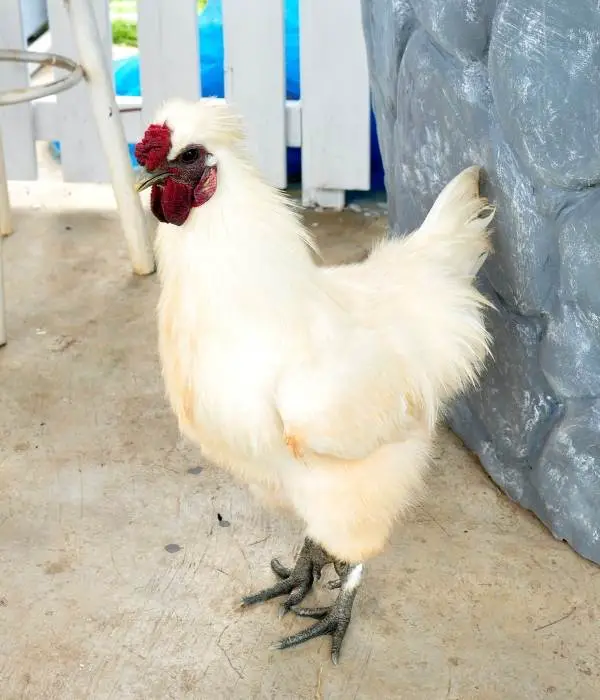
Silkies are small, fluffy birds from China known for their satin‑like plumage, black skin, five toes, and blue earlobes. Roosters weigh about 3–4 pounds and hens up to 2 pounds.
The Silkie’s fur‑like feathers lack barbicels, which gives them a unique “hairy” appearance. Chinese texts mention black‑boned chickens more than a thousand years ago, and the breed reached Europe along the Silk Road.
Silkies come in bearded and non‑bearded varieties and sport walnut combs. In Asia, they are valued not only as ornamental birds but also in traditional medicine and cuisine.
Benefits of Silkies
- Gentle companions: These docile birds are friendly and suitable for children and small gardens.
- Unique appearance: Their unusual feathers and colours make them popular in poultry shows.
- Broody hens: Silkie hens are devoted mothers and will hatch eggs from other breeds.
- Cold-hardy: Despite their small size, they cope well with cold weather.
Small problems
- Poor egg production: Hens lay about 100–120 small cream‑coloured eggs per year.
- Limited meat: Their small size and dark meat make them less desirable for the table.
- Require dry housing: Feathers lack waterproofing; keep them dry to prevent chilling.
15. Faverolles Chicken
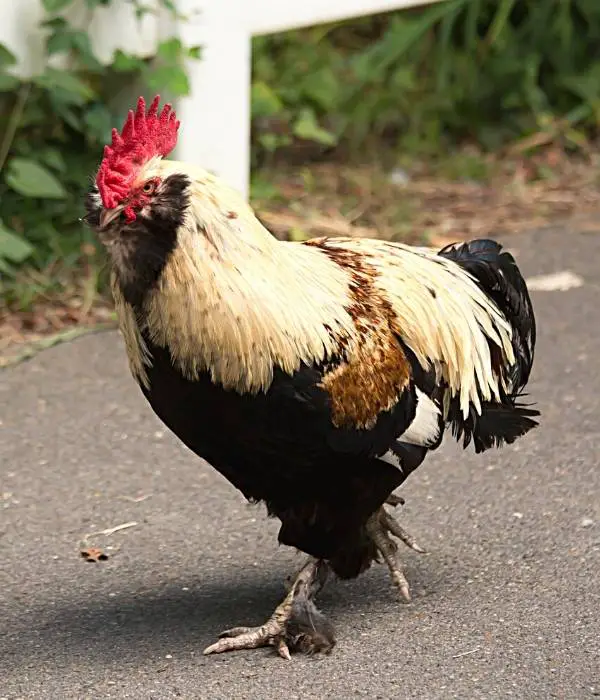
Faverolles are fluffy French birds with muffs and beards. Roosters weigh around 8 pounds and hens 6½ pounds.
Originating in the Faverolles region of France, this breed was created by crossing Houdans, Dorkings, and other local chickens.
It combines qualities of meat and egg breeds and is easily recognised by its fifth toe and salmon‑coloured plumage in the most common variety. Faverolles roosters are particularly gorgeous with straw‑coloured hackles and rich mahogany breasts.
Benefits of Faverolles
- Friendly personalities: They’re gentle, curious, and good with children.
- Dual‑purpose: Hens lay 180–200 medium eggs annually, and roosters provide ample meat.
- Cold hardy: Their dense plumage and feathered feet make them suitable for cooler climates.
- Good brooders: Many hens go broody and raise chicks well.
Small problems
- Require clean housing: Feathered feet and muffs collect dirt; regular grooming is needed.
- Not heat-tolerant: Provide shade and cool water in hot weather.
- Can be bullied: They are docile and may be picked on by more assertive breeds.
16. Sussex Chicken
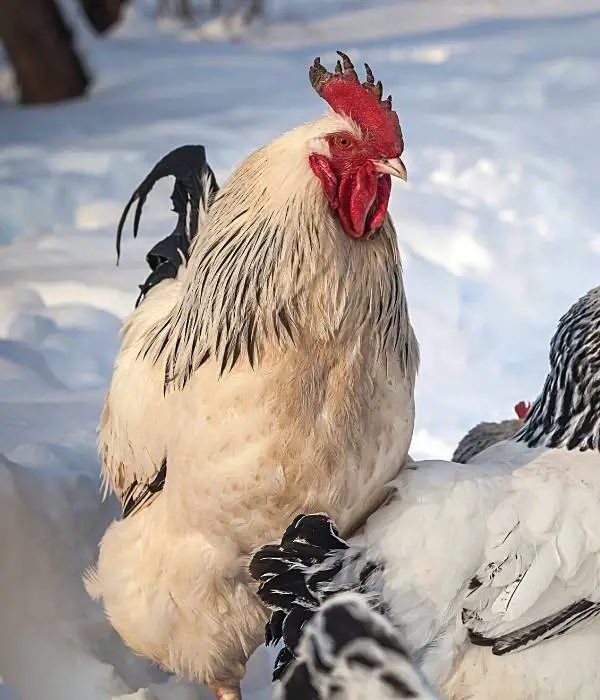
The Sussex is a dual-purpose breed from Britain with a history going back to Roman times. The roosters weigh about 9 ½ pounds, and the hens weigh 7 ½ pounds.
The Sussex is one of the oldest British breeds and comes in a number of colours, such as speckled, light, and red.
The light Sussex rooster has a white body with a black tail and a stripe of black down the hackles.
In earlier times, they were valued for their quick on-pasture fattening ability and for being good egg layers during wintertime. Their active and curious nature makes them good free-range birds.
Benefits of Sussex
- Year‑round layers: Hens lay around 180–200 large light‑brown eggs annually and start laying at about eight months.
- Friendly and confident: They’re curious birds that enjoy human interaction and make good pets.
- Hardy: Sussex chickens thrive in a variety of climates and require little special care.
- Dual‑purpose: They’re large enough for meat production yet maintain good egg output.
Small problems
- Prone to obesity: Monitor feed to prevent overweight birds.
- May be loud: Roosters can be vocal, so consider neighbours when keeping them.
17. Rhode Island Red Chicken
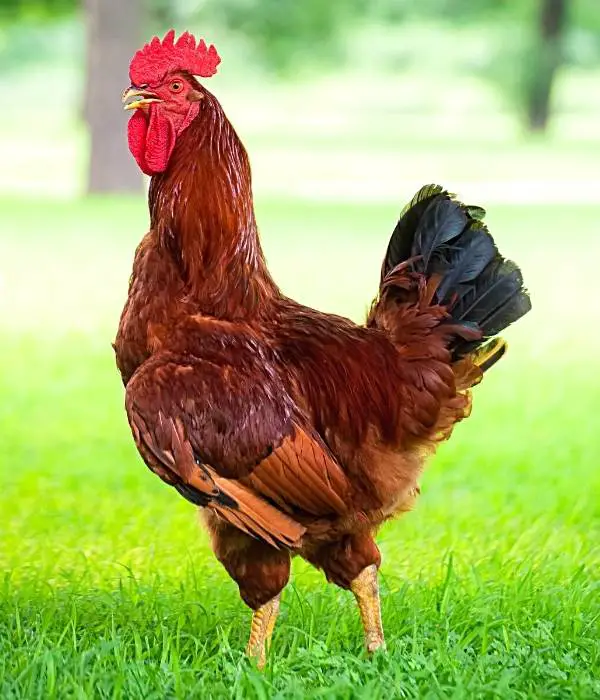
Rhode Island Reds (RIRs) are traditional dual-purpose fowl developed in America during the 19th century. The roosters weigh around 8-9 pounds; hens weigh around 6-7 pounds.
RIRs were produced by crossing Malay, Java, and other birds to produce a bird that could tolerate the New England environment and lay eggs heavily.
The roosters exhibit a striking, deep mahogany plumage, black tail feathers, and rectangular stature. Being hardy and adaptable contributed to RIRs being the source of many modern production strains.
Benefits of RIRs
- Prolific layers: Good hens produce 200–300 medium‑large brown eggs per year.
- Hardy and adaptable: They tolerate a wide range of climates and conditions.
- Low maintenance: They’re robust birds that thrive on free range or in confinement; easy for beginners.
- Dual‑purpose: Roosters provide good carcasses, and hens continue laying for several years.
Small problems
- Temperament varies: Some roosters can be assertive or aggressive.
- Can be noisy: Consider neighbours and coop placement.
18. Jersey Giant Chicken
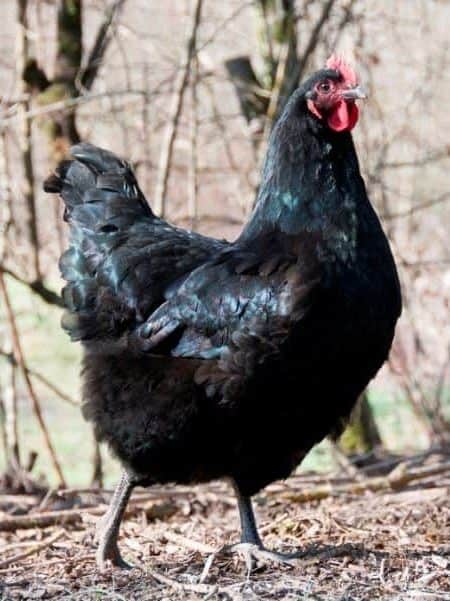
Jersey Giants are the largest American chicken breed. Roosters weigh 13–15 pounds and hens 10–11 pounds.
Developed in New Jersey in the late 1800s by brothers John and Thomas Black, the Jersey Giant was intended to replace the turkey as a table bird.
These gentle giants come in black, white, and blue varieties and have a moderate single comb and clean legs. They grow slowly but produce enormous carcasses and extra‑large eggs.
Benefits of Jersey Giants
- Huge meat birds: They were developed to replace turkeys and provide large carcasses; one bird can feed a family.
- Calm and friendly: Despite their size, Giants are docile and often enjoy being held.
- Good layers for their size: Hens lay 150–200 extra‑large eggs per year.
- Cold hardy: They withstand cold winters and survive the colder months.
Small problems
- Slow growth: They take 8–9 months to reach harvesting weight.
- High feed consumption: Their size means a bigger feed bill.
- Require space: Giants need larger coops, low roosts and spacious runs.
19. White Leghorn Chicken
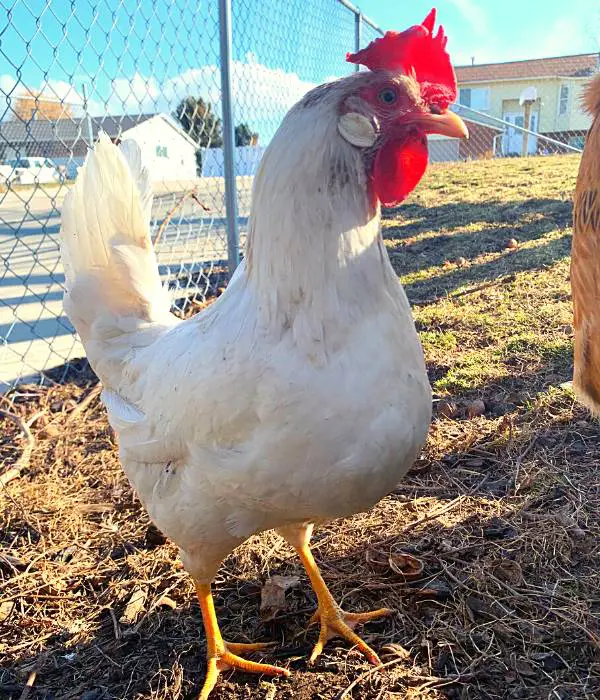
Leghorns are lightweight Mediterranean birds prized for their egg production. White Leghorn roosters weigh about 6 pounds and hens about 5 pounds.
Originating from the Italian port of Livorno (anglicised to “Leghorn”), these chickens were refined in America and Britain to become prolific layers. Roosters carry a large single comb and white earlobes, and the breed comes in many colours, although the white variety is the most common in commercial flocks. Leghorns are lightweight with long tails and a high tail carriage.
Benefits of White Leghorns
- Egg machines: Hens lay 280–320 large white eggs each year.
- Efficient feed conversion: They produce lots of eggs while eating less feed than heavier breeds.
- Active foragers: Their alert and lively nature helps them evade predators and find food.
- Heat-tolerant: Leghorns thrive in warm climates; rose‑comb varieties handle cold better than single‑comb birds.
Small problems
- Flighty and noisy: They’re skittish around people, can fly over fences, and are quite vocal.
- Low meat value: They are slender birds with little meat.
- Can bully gentle breeds: Their assertiveness may cause issues in mixed flocks.
20. Minorca Chicken
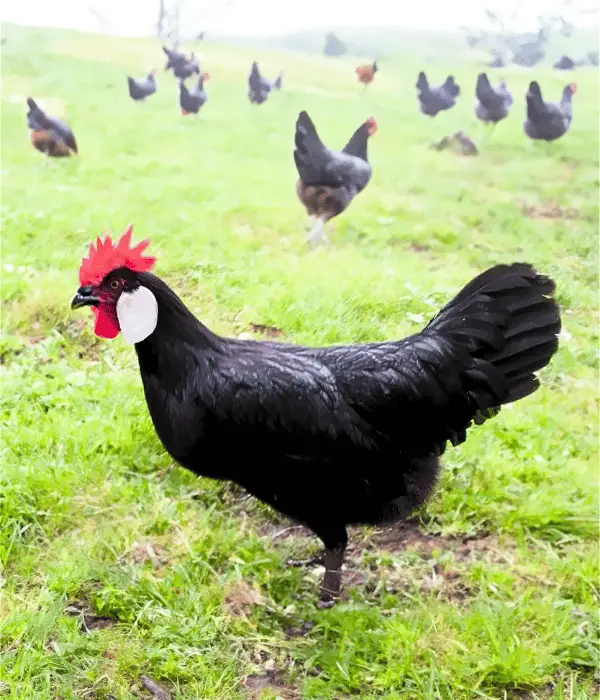
Minorca chickens are the largest of the Mediterranean breeds. Roosters average 9 pounds and hens 7½ pounds. They are excellent free‑range birds and lay very large white eggs.
Named after the Spanish island of Menorca, Minorcas were once prized for their ability to produce extra‑large eggs while thriving in hot, dry climates. The breed is typically black with a red face, enormous white ear‑lobes, and a large single comb that may flop over on roosters. Minorcas mature slowly but will lay well into old age.
Benefits of Minorcas
- Huge white eggs: Hens lay extra‑large white eggs; they are known for their egg size.
- Heat tolerant: They thrive in warm climates and prefer free range.
- Self‑reliant: Minorcas forage well and require little intervention; ideal for experienced keepers.
Small problems
- Flighty and independent: They are not cuddly and may be too active for children.
- Poor brooders: Hens rarely go broody; use an incubator or a broody hen.
- Prone to frostbite: Large single combs can suffer in freezing weather; protect combs with ointment.
21. Ayam Cemani Chicken
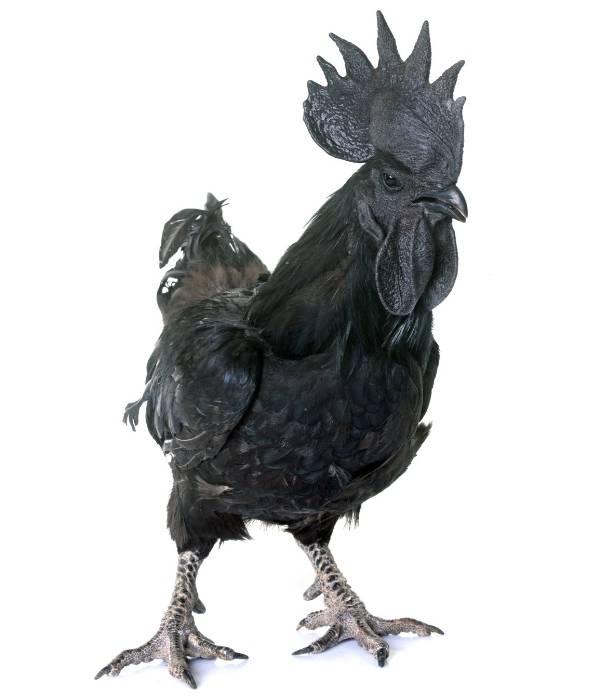
Ayam Cemani is an Indonesian breed famous for its black feathers, skin, bones, and internal organs. Roosters weigh 4.4–7 pounds and hens 3.5–5.5 pounds.
This mysterious breed has been kept on the island of Java for centuries and is associated with traditional rituals. The fibromelanistic gene causes its tissues to be black throughout, including the comb, wattles, and even the meat.
Ayam Cemani roosters have a long, sweeping tail, pea comb, and a metallic green sheen to their plumage. Because they mature slowly and hens lay relatively few eggs, they are most often raised for their rarity and unique appearance.
Benefits of Ayam Cemani
- Striking appearance: Their jet‑black plumage with iridescent sheen makes them a unique addition to any flock.
- Adaptable: They handle both hot and cold weather and cope well in various conditions.
- Moderate meat: Although small to medium-sized, they are valued as a delicacy in some cuisines.
- Rarity: Because they’re scarce and unusual, breeding Ayam Cemani can be a rewarding niche hobby.
Small problems
- Poor egg layers: Hens lay only 60–100 cream‑tinted eggs annually.
- Flighty temperament: They are gentle but can be skittish; not ideal for young children.
- High cost: Purebred Ayam Cemani chickens are expensive and may be hard to find.
Tips for Choosing and Raising Roosters
Below are a few quick tips on choosing the best rooster breed from the above list:
Plan your coop and run: Large breeds require more space than small breeds, so remember to account for lower roosts. The plans we suggest are available in our coop design guide, so you can make sure your coop is large enough. Remember to provide 4–5 square feet per bird inside and 10 square feet outside for heavy breeds such as the Brahma.
Nutrition: Every rooster needs a balanced diet of good layer or grower pellets, plenty of scratch grains, and leafy greens. For information on feeding roosters, our feeding guide will give you details.
Managing aggressive behavior: Even the friendliest breeds can be territorial. Provide plenty of enrichment opportunities, and if one rooster becomes too aggressive, you may want to remove him from the flock.
Climatic considerations: Seasonality relates to the breed of rooster you select. Cold-tolerant breeds (Brahma, Cochin, Faverolles, Jersey Giant) require space with good ventilation, but you’ll want to be careful that your chickens are not exposed to a draft. Heat-tolerant breeds (Leghorn, Minorca, Ayam Cemani) will need shade and cool water options.
As you can see, a rooster can be more than just a noisy bird – he can protect your hens, help with sustainable breeding, and beautify your yard.
You can use this guide to help you pair your needs with the best breed for you, and don’t forget to look in our coop and feeding guides for additional helpful information.
